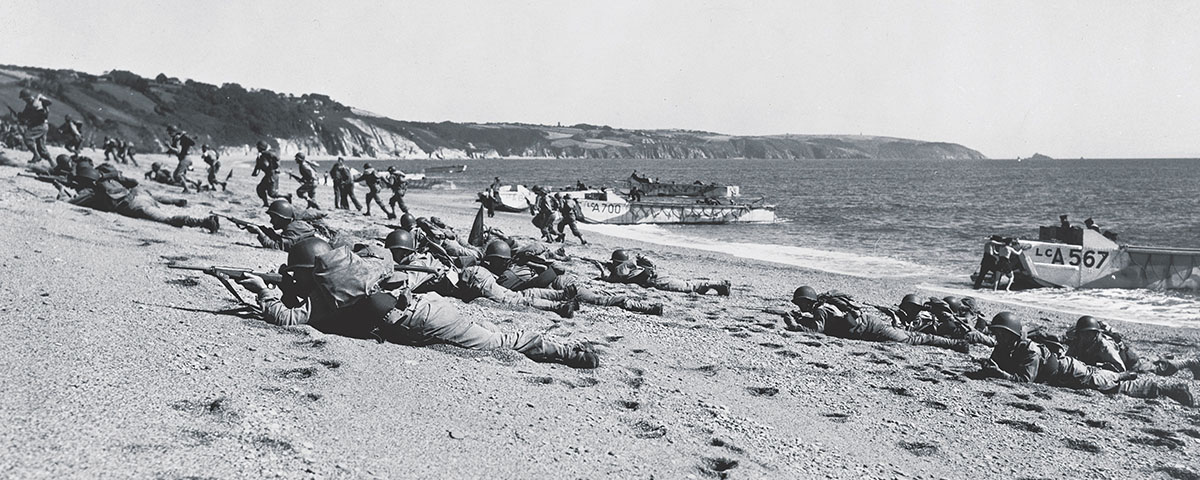Little more than five weeks before the Allied invasion of Normandy—the largest amphibious assault the world has ever seen—a training exercise gone awry resulted in appalling carnage. Yet the April 27–28, 1944, fiasco at Slapton Sands, England, which claimed the lives of more than 1,000 men, may have assured the success of D-Day.
Code-named Exercise Tiger, it was to be a dress rehearsal for Operation Overlord, and that stretch of the Devon coast proved ideal training ground for forces tasked with landing on Utah Beach. Its coarse gravel, shallow lagoon and seaside bluffs closely resembled the terrain Allied soldiers would soon traverse in France. Supreme Allied Commander General Dwight D. Eisenhower ordered planners to make the exercise as realistic as possible, down to the use of live gunfire from naval vessels and shore-based artillery.
In advance of the initial practice landing at 7:30 on the morning of the 27th the British heavy cruiser HMS Hawkins was to shell the beachhead, stopping just before the troops reached shore. As some of the landing ships were running late, U.S. Rear Adm. Don P. Moon, the officer in command of the exercise, pushed H-hour back to 8:30 a.m. Unfortunately, several landing craft already en route never received word of the change, and when the soldiers aboard clambered ashore, they came under devastating friendly fire. Some 300 men were killed in the accident.
Early the next morning eight LSTs (tank landing ships)packed with U.S. troops and equipment formed up in Lyme Bay. From there the ships would head toward Slapton Sands. As the boats converged, however, a patrol of nine fast and well-armed German E-boats picked up the heavy radio traffic near Lyme Bay and zeroed in on the transports. The fully loaded LSTs (nicknamed “large slow targets” by the troops) made easy pickings. Making matters worse, the convoy had no destroyer escort, as the one assigned to the exercise had collided with an LST and diverted to Plymouth for repairs. The flotilla’s only escort, the Royal Navy corvette Azalea, spotted the E-boats but was unable to warn the convoy, as the American vessels were using a different radio frequency.
The Germans struck with abandon, their torpedoes hitting three LSTs, sinking two and severely damaging the third. Of the hundreds of soldiers and sailors aboard, 749 were either killed outright or drowned in the icy channel water, pushing the death toll for the exercise over 1,000. In one of war’s tragic ironies, many men had improperly donned their life jackets and then drowned when the weight of their backpacks forced them facedown underwater.
Allied commanders ordered a news blackout as search teams quickly and quietly recovered the bodies. Of immediate concern was the fate of 10 officers participating in the exercise who had top-level clearance and knowledge of the D-Day invasion plans. Fortunately, all 10 were accounted for, and Operation Overlord was given the green light.
Though Exercise Tiger resulted in the worst loss of life for American troops since the Dec. 7, 1941, Japanese attack on Pearl Harbor, and despite the fact five times more men died at Slapton Sands than were killed storming Utah Beach on D-Day, the Allies learned valuable if grim lessons essential to the success of the invasion. Foremost among the positive changes, the Allies standardized radio frequencies, trained troops how to properly don life jackets and established more effective procedures for retrieving men from the water. As abhorrent as the losses were, the takeaways from the rehearsal paved the way toward the Allied foothold in France and the eventual liberation of Western Europe.
Today an amphibious M4 tank, recovered from the sea in 1984, overlooks Slapton Sands. Recognized by Congress as the Sherman Tank Memorial Site [exercisetigermemorial.co.uk], it stands as a somber tribute to the men who died and to a truth so long buried.





